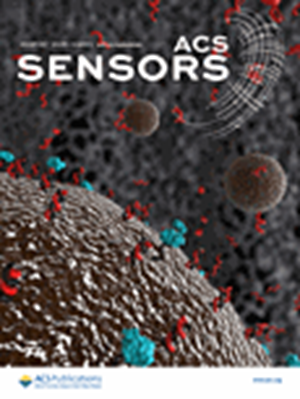A DNA Fishhook Electrochemical Sensor Based on a Potassium Ferricyanide-Mediated Dual-Signal-Correlation Enhanced Electrocatalysis Reaction for a Simultaneous and Correlation Assay of Multiple Biomarkers.
IF 8.2
1区 化学
Q1 CHEMISTRY, ANALYTICAL
引用次数: 0
Abstract
Simultaneous detection and correlation analysis of multiple biomarkers in a single run are crucial to improving the detection specificity and indicate disease progression, but they remain a challenge. Herein, we propose a DNA fishhook electrochemical sensor based on the potassium ferricyanide-mediated dual-signal correlation enhanced electrocatalysis reaction (DEER). The designed T-shaped DNA fishhook scaffold has two "hooks" to recruit their respective "fish" (targets) with the help of the "fishing bait" (signal probes, Sp), resulting in the different targets and Sp being specifically captured by the DNA fishhook to the electrode interface, respectively. The proposed DEER not only effectively improves the detection sensitivity without introducing nucleic acid amplification but also can reflect the logical correlation between the targets. As proof of principle, the DNA fishhook sensor was successfully applied in the simultaneous detection of two related gene sequences of SARS-CoV-2 and the active-state assay of the PI3K/AKT signaling pathway. In general, our DNA fishhook sensor provides a meaningful potential tool for the sensitive simultaneous detection and correlation analysis of multiple targets.基于铁氰化钾介导的双信号相关增强电催化反应的DNA鱼钩电化学传感器,用于多种生物标志物的同时和相关分析。
在一次运行中同时检测和相关性分析多种生物标志物对于提高检测特异性和指示疾病进展至关重要,但这仍然是一个挑战。在此,我们提出了一种基于铁氰化钾介导的双信号相关增强电催化反应(DEER)的DNA鱼钩电化学传感器。设计的t形DNA鱼钩支架有两个“钩”,借助“鱼饵”(信号探针,Sp)招募各自的“鱼”(靶标),使得不同的靶标和Sp分别被DNA鱼钩特异性捕获到电极界面。该方法不仅在不引入核酸扩增的情况下有效提高了检测灵敏度,而且能够反映靶点之间的逻辑相关性。作为原理证明,DNA鱼钩传感器成功应用于SARS-CoV-2的两个相关基因序列的同时检测和PI3K/AKT信号通路的活性状态测定。总的来说,我们的DNA鱼钩传感器为多靶点的灵敏同时检测和相关性分析提供了有意义的潜在工具。
本文章由计算机程序翻译,如有差异,请以英文原文为准。
求助全文
约1分钟内获得全文
求助全文
来源期刊

ACS Sensors
Chemical Engineering-Bioengineering
CiteScore
14.50
自引率
3.40%
发文量
372
期刊介绍:
ACS Sensors is a peer-reviewed research journal that focuses on the dissemination of new and original knowledge in the field of sensor science, particularly those that selectively sense chemical or biological species or processes. The journal covers a broad range of topics, including but not limited to biosensors, chemical sensors, gas sensors, intracellular sensors, single molecule sensors, cell chips, and microfluidic devices. It aims to publish articles that address conceptual advances in sensing technology applicable to various types of analytes or application papers that report on the use of existing sensing concepts in new ways or for new analytes.
 求助内容:
求助内容: 应助结果提醒方式:
应助结果提醒方式:


